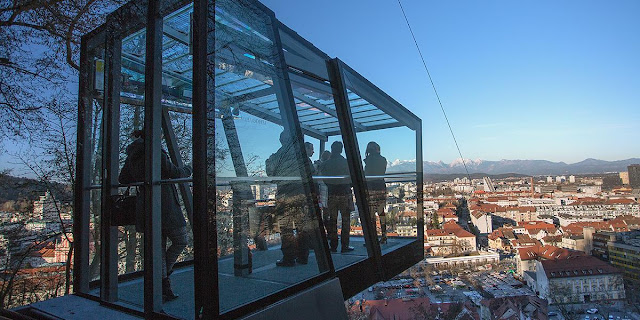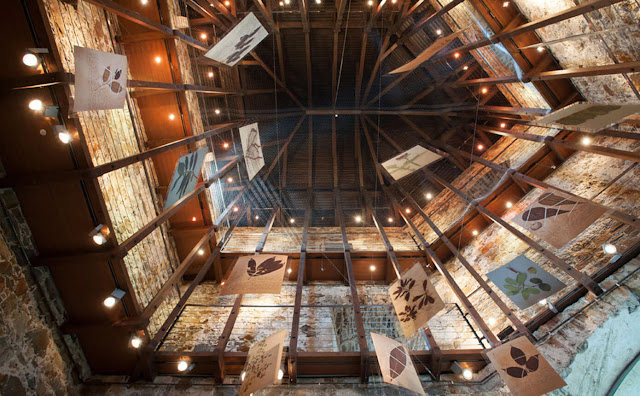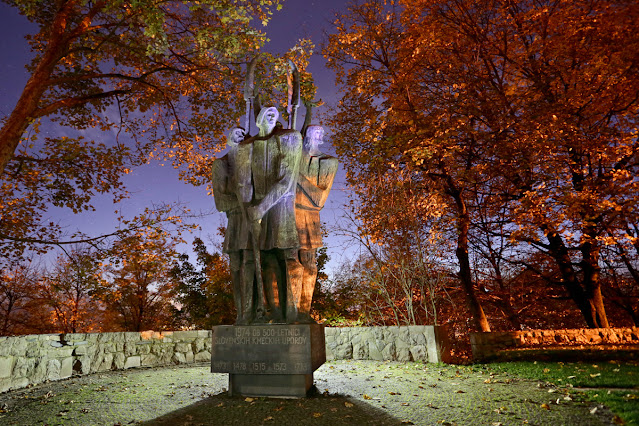Maya Angelou
 |
| Ljubljanica River, Ljubljana, Capital of Slovenia Seventeen bridges cross this river |
 |
| A tad cheesy but you can buy one of these stuffed elephants left on your bed at check-in. Hotel Slon |
On his way from Spain, he was bringing one of his wedding presents: an elephant called Suleiman. At that time, the Sultan Suleiman the Magnificent was Austria’s most terrible enemy. Therefore, domesticating such a powerful animal under that name was a symbol of great power.
Maximilian stopped at the best inn in Ljubljana with his escort and the wonderful animal, which impressed the population tremendously. The hotel Slon was later built (latest 1937) on the site of this inn. The memory of Suleiman the elephant was still very strong in the city, so the guesthouse, and later the hotel, were named Slon (the Slovenian word for elephant).
 |
| Aerial view of the Ljubljana Castle www.travelslovenia.org |
 |
| Taking a funicular to get up to the castle www.ljubljanski.si |
Funicular Railway
At the end
of 2006, the Municipality of Ljubljana connected the Ljubljana Castle to the
old town center with an urban means of passenger transport. Due to spatial and
design requirements, the best solution proved to be a cable car or, more
specifically, a funicular railway. It
became so handy and popular that by 2024, it had already accommodated over 6
million passengers.
Dr Ivan Hribar, the Mayor of Ljubljana, wrote in a letter to the Austro-Hungarian authorities of the time: 'Because the view from the spaces in question (of the Ljubljana Castle) are charmingly beautiful, and because it would be good to make use of the current shady courtyard, if only we built an elevator with which one could reach the top for a mere ten kreutzers or less, it would no doubt attract many visitors, particularly on summer evenings.'
The
letter, in which the mayor proposes an initiative to purchase the castle for
the city, was sent in 1897. Ideas regarding a means of transport continued to
take shape in 1905, when the Municipality of Ljubljana purchased the castle,
this time on the part of architects Boris Kobe and Edo Mihevc. The final
project was taken up in 2005, and the first passengers were transported by
funicular in late December 2006.
Construction
of the railway revealed the ruins of the medieval defensive wall, which were
strengthened and displayed along the entire length of the tracks. Similarly, at
the lower station, the remains of a defensive moat can be observed along the
foot of the defensive walls, on which houses were subsequently built.
The only downside as far as I am concerned is that the funicular doesn’t stay open very late (6 or 8pm depending on the season) so
if you go to the castle area for dinner, there’s a good chance you’ll miss the
last run of the day and will have to walk back down to the center of town, but
that walk will give you a different perspective of town so not a bad idea after
all.
Statistics: 60 sec per trip, 33 persons per trip,
500 persons per hour
 |
| Castle Viewing Tower near entrance |
Ljubljana
and its Castle
Due to its
location at the crossroads of natural routes the Ljubljana basin was settled as
early as pre-historic times. The first
settlement on the Castle hill dates back to the late Bronze Age (3300-1200 BCE).
Historically,
castles had the most stunning vantage points, and the Ljubljana Castle is no
exception. Today’s Viewing Tower was
increased by 4 feet (1.2 m) in 1982, so that its upper platform is exactly 400
meters (1,312 feet) above sea level. No
longer a fire warning tower, it offers a wonderful panorama of Ljubljana.
As you get
off the funicular railway you enter the Rock Hall, renovated as a multilevel
layout with interweaving of varied building materials grounded by the
geological structure of primeval large rocks.
A well-integrated mixture of glass, steel, ancient rocks, and wood, it
feels like it is floating. An artistic
Ljubljana Dragon wire sculpture awaits you on its lower floor.
Part of
this castle was first mentioned in 1544.
Much of what you see now has been aptly renovated. Historians aren’t sure if the French
destroyed part of it in 1813 or if it fell apart naturally, from the forces of
nature and simple neglect.
Much has
changed here. From Archers’ Tower to a restaurant surrounded by beautiful
sgraffito wall paintings representing folk songs and tales of Slovenia. From private residences to exhibition
halls. From open loft to small concert
hall or theater. From stables, granary
or barracks to more eating or meeting areas.
The Chapel
is one of the oldest parts of the castle, dedicated to St George, St Pancras
and St Helena since 1489. The original
Gothic chapel was later rebuilt in the Baroque style, although some Gothic
paintings remain around the altars, the entranceways, and the windows. In 1747 it was decorated with the
coats-of-arms of its numerous provincial governors.
It is very rare for religious buildings to be decorated with secular
content. This chapel is therefore
regarded as a unique jewel amongst European sacred buildings.
The
Gunpowder Room was built in the 15th century. It endangered the castle and the city’s
residents as lightning struck the room on several occasions. Once after a storm, its door was found some 2.5
miles (4km) away! In its place, you can
now see a permanent exhibition of Slovenian history.
As any
castle worth its name, you’ll find the remains of a jail under the Palatium
(place for formal receptions) where there is a series of preserved solitary
confinement cells.
There is
also the Erasmus Tower, named after the robber baron Erasmus Lueger. Archaeologists believe it served as a noble
prison from which he escaped with bribes.
However, his death awaited him at home, in the Predjama Castle near
Postojna, Slovenia. I also visited that
castle (in a later post). It is
interesting to make the connection of the same robber baron between these two
famous Slovenian Castles.
The Pentagonal
Tower is from the 16th century, it was the main entrance to the Castle’s
courtyard and connected to the outside world by two drawbridges over a
defensive moat. Flanked by two openings,
one for horses and carriages, the other smaller one, for people. The upper level was the residence of the
keeper of the castle who administered all its buildings. Today, the upper floor is an open loft and
the tower is dedicated to exhibitions, small concerts and theatrical
performances.
The
Estates Hall (former living spaces of the provincial governor), the Hribar Hall
(named after Ivan Hribar, who constructed the waterworks for the city and
became its mayor after the catastrophic 1895 earthquake), the Armory which also
served as stables, granary, barracks and now another fine restaurant within the
walls of this castle.
The City
of Ljubljana purchased the castle from the state in 1905, but further
investment in renovation was not possible at that time. This did not occur until the middle of the 20th
century, when, in order to preserve what had been a symbol of the city for many
centuries, preparations for a thorough renovation of the castle commenced.
Just south of the castle, on a fortified viewing terrace, a very large bronze sculpture of rebels with peasant tools can be seen. Erected in 1974 to mark the 500th anniversary of the peasant revolts in Slovenia. Work of the sculptor Stojan Batič. Long gone are the drawbridges and moat leaving in their places well designed and airy courtyards and access to the castle but it is still a beautiful site to visit.
 |
| View of Ljubljana from castle |
 |
| Archers Tower surrounded by beautiful sgraffito wall paintings Representing folk songs and tales of Slovenia |
 |
| Rock Hall, mixing old and very new |
 |
| The Ljubljana Dragon wire sculpture by Tea Curk Sorta, 2018 |
 |
| The Pentagonal Tower - now exhibition space |
 |
| The Peasant Revolt Sculpture celebrating 500 years of the peasant revolt in Slovenia |
 |
| Famous triple-bridge leading to the main Prešeren Square |
Plečnik removed the metal railings from the old stone
bridge and furnished all three bridges with massive stone balustrades and
lamps. From each of the side bridges, two stairways lead to terraces situated
just above the river, where poplar trees were planted to contribute to the
overall appearance of the Bridge.
 |
| Everyone enjoys this beautiful river Many terraces and stairways to access it and take advantage of it |
Ranked as one of Europe’s 50 most beautiful squares, I
would agree after seeing it.
Dedicated to the greatest Slovenian poet, Dr. France Prešeren
and in the middle of Ljubljana, it is hard to miss it if you just meander for a
bit since it is part of the old town’s pedestrian area. It is oval in shape, paved with cobblestones
and busy with street entertainment and surrounded by many small eateries. Crowded with people, sounds, and history, it
can get a bit hectic to walk through it at times. The locals often meet here saying: ‘Let’s
meet at the statue…’
Ljubljana
is probably one of the few cities in the world whose central town square is
adorned with a statue (unveiled 1905) of a poet rather than some political or
military hero. The statue of France Prešeren (1800-1849) reminds us that the Slovenes
are a nation founded on books, the written word and language. The poet’s statue
is gazing directly at the window of his beloved muse, Julija Primic. Prešeren was hopelessly in love with Julija
for many years, but the girl lived under the care of her strict parents and
never returned his love. Prešeren dedicated to her a large number of his poems
written in sonnet form.
After Slovenia gained its independence, Prešeren’s poem
Zdravljica (A Toast) became the Slovenian national anthem. A verse of which is engraved on the Main Street
in Ljubljana.
The Slovenian 2-Euro coin features his profile. On the day of his birth, December 3rd,
Slovenians celebrate The Merry Day of Culture. This is when most of Slovenia’s
cultural institutions open their doors to visitors for free. That’s how important this poet was to
Slovenia.
A large earthquake in 1895 destroyed a lot of the older buildings. After that great earthquake, new bourgeois houses grew up around the square as well as the Central Pharmacy. The first decade of the 20th century saw the Art Nouveau refurbishment of Hauptman House and the building of Urbanc House, one of Ljubljana's most beautiful Art Nouveau buildings, which housed the city's first department store. Kresija Palace is another building bordering the square; the palace houses municipal offices, the city’s visitor center and the Kresija Gallery.
The rebuilding period between 1896 and 1910 is
referred to as the ‘revival of Ljubljana’ not just because of these
architectural changes, but for reform of urban administration, health,
education and tourism that followed. During that period, 436 new buildings were
created and hundreds of buildings were renovated or extended in the Vienna
Secession style. Most of Ljubljana's bridges, monuments, parks, and main
buildings date back to the post-earthquake development.
The ‘square’ was last renovated in 2007. Great place for people watching but one can’t be in a rush to get through this busy center.
 |
| Main square with sculpture dedicated to the greatest Slovenian poet, Dr. France Prešeren Accompanied by his muse holding a laurel |
 |
| Hauptman House - Art Nouveau on main square |
 |
| Kresija Palace and bikes at forefront |
.png) |
| Another famous bridge, the dragon bridge |
Legend has it that Ljubljana was founded by Jason, the
hero of Greek mythology who stole the golden fleece from King Aeetes and then
fled aboard the Argo with his comrades, known as the Argonauts, across the
Black Sea and up the Danube and the Sava until they reached the Ljubljanica
River. There, they dismantled their ship
in order to carry it overland to the Adriatic coast where they rebuilt the
vessel and set sail back to Greece. On
their way to the coast, they stopped at a large lake in the marshes near the
source of the Ljubljanica where a dragon was said to dwell, whereupon Jason
fought, defeated and killed the monster.
The
Dragon Bridge or Zmajski Most, is a fairytale-like bridge that crosses the
Ljubljanica River to the Old Town of Ljubljana. As you enter or leave Ljubljana
via the Dragon Bridge, a pair of striking green dragons welcomes you. Their
fire breathing tongues dangling out and their sculpted wings poised over the
bridge make the dragons prominent from a distance.
The original design included four winged lions instead
of winged dragons with curling tails. Some local
legends believes the dragons wag their tail when a virgin crosses the bridge.
Other than this legendary story, the bridge is important as it connects the Old
Town with the modern city.
The Dragon Bridge replaced an old 1819 oak bridge
which was heavily damaged during the 1895 earthquake. The authorities decided to use reinforced
concrete mainly for economic purposes as it was cheaper than the more common stonework
of the days. The bridge opened to the public in
1901 and was originally known as the Jubilee Bridge of Emperor Franz Joseph I,
but that name was soon forgotten because of its famous four dragons. In
the early 1980's, the bridge was renovated with a lightweight concrete.
Dragon symbols have thus been present in Ljubljana
since ancient times. The dragon was
originally present on the medieval coat of arms as a decoration, but later
assumed a more central position. From
its initial portrayal as a monster, the dragon gradually transformed into a
symbolic protector of the city, embodying power, courage and wisdom.
.png) |
| Ljubljana's Coat of Arms |
 |
| A bit of autumn colors with another bridge |
 |
| Day or night |


No comments:
Post a Comment
We are always happy to hear from you but at times it may take a while to get a reply - all depends if we have access to the internet.